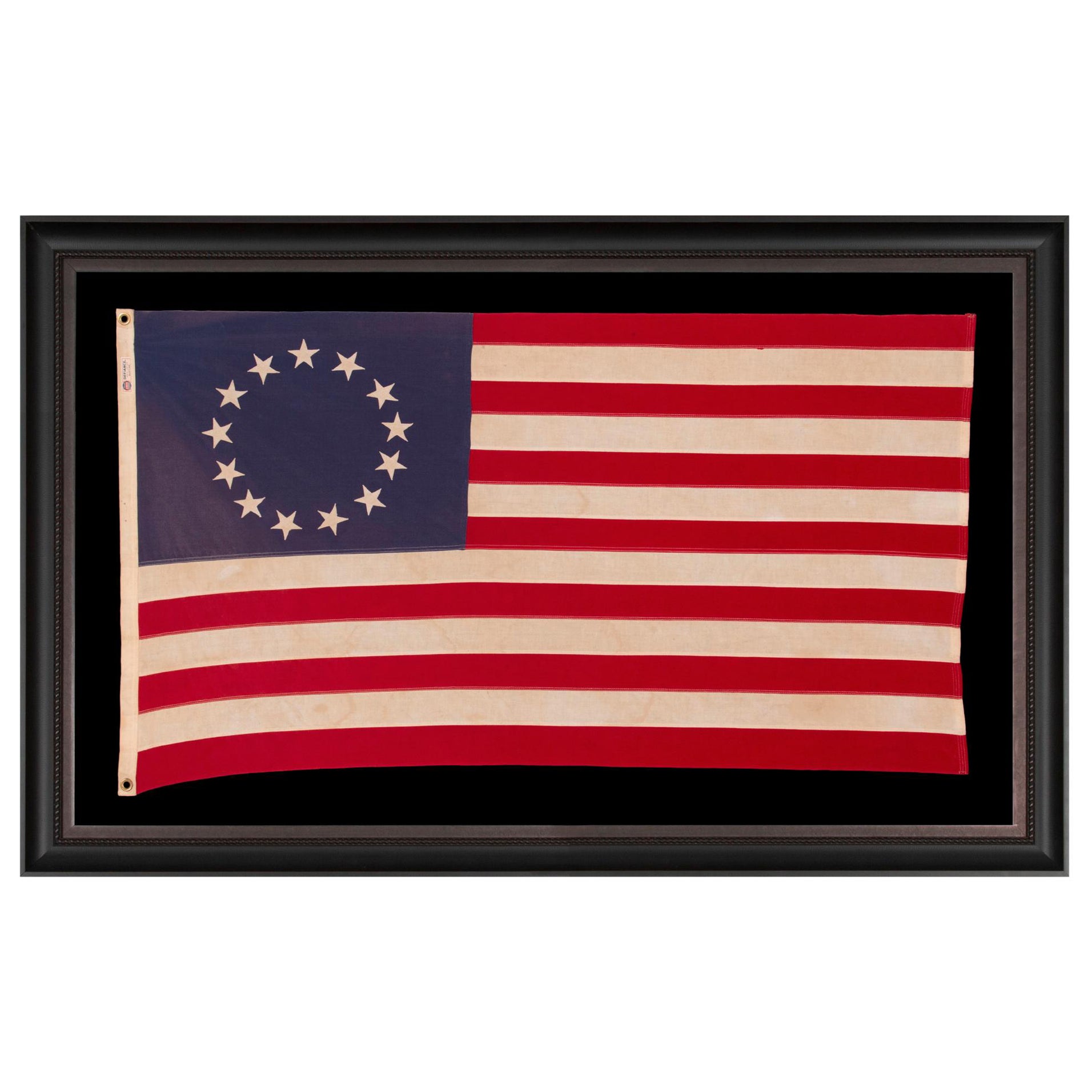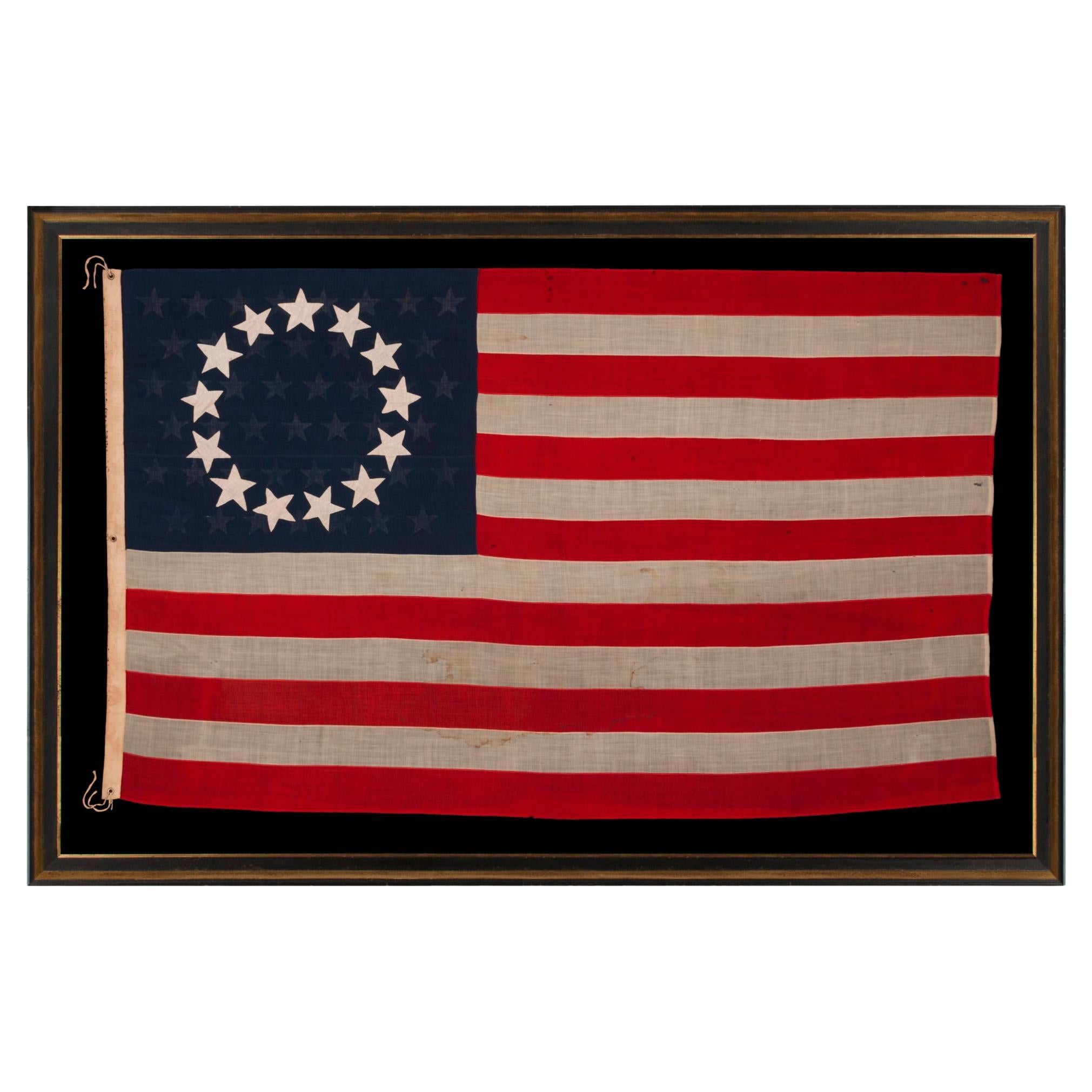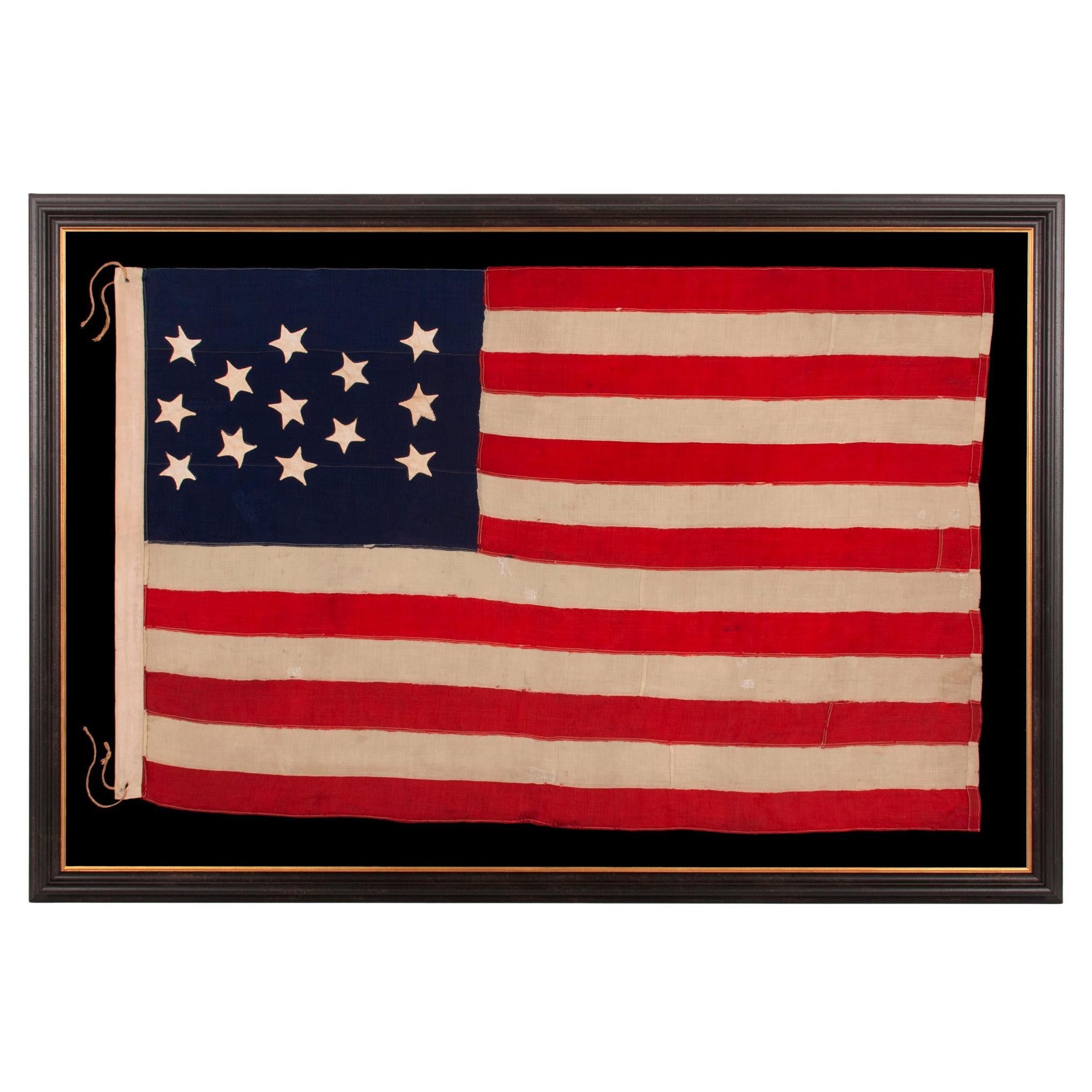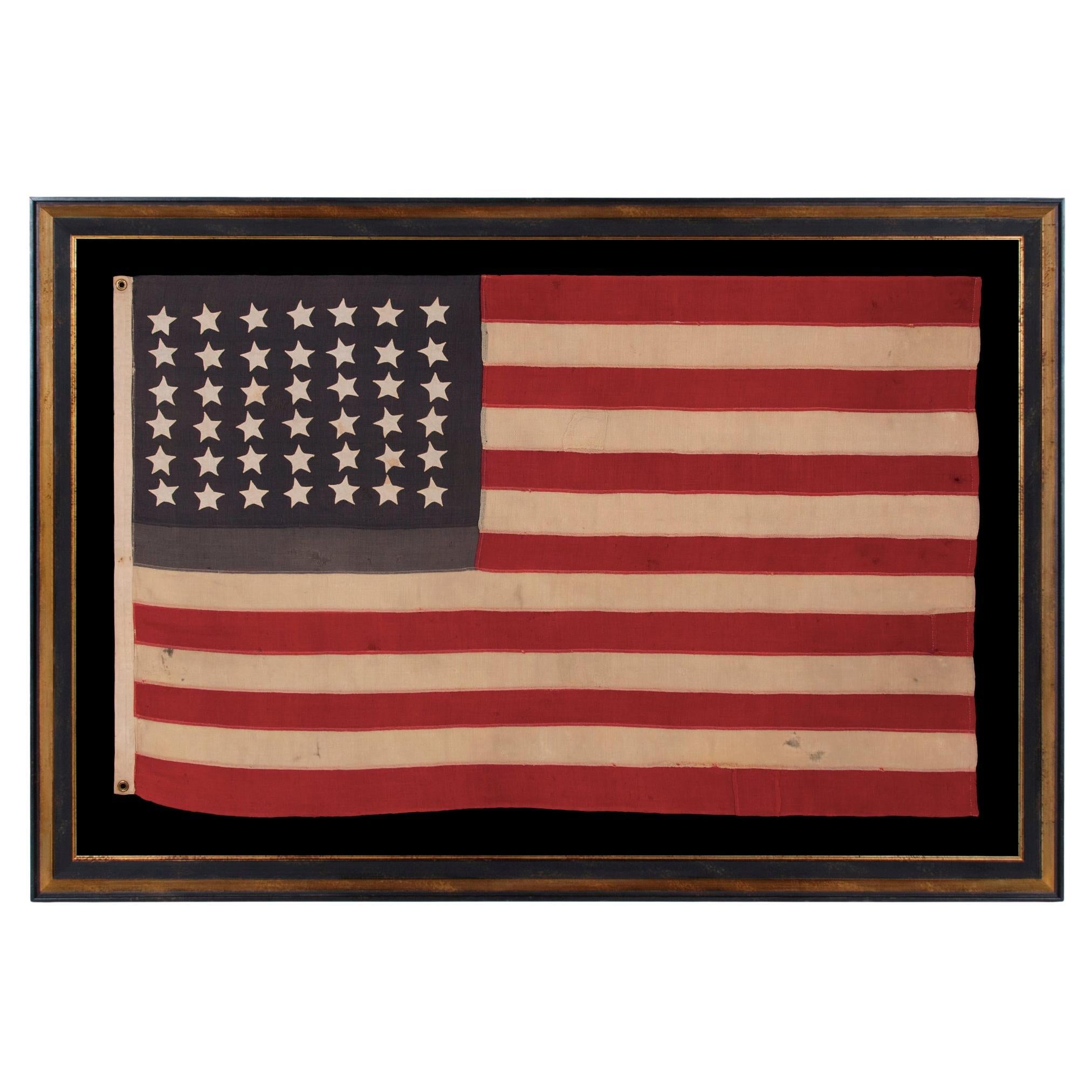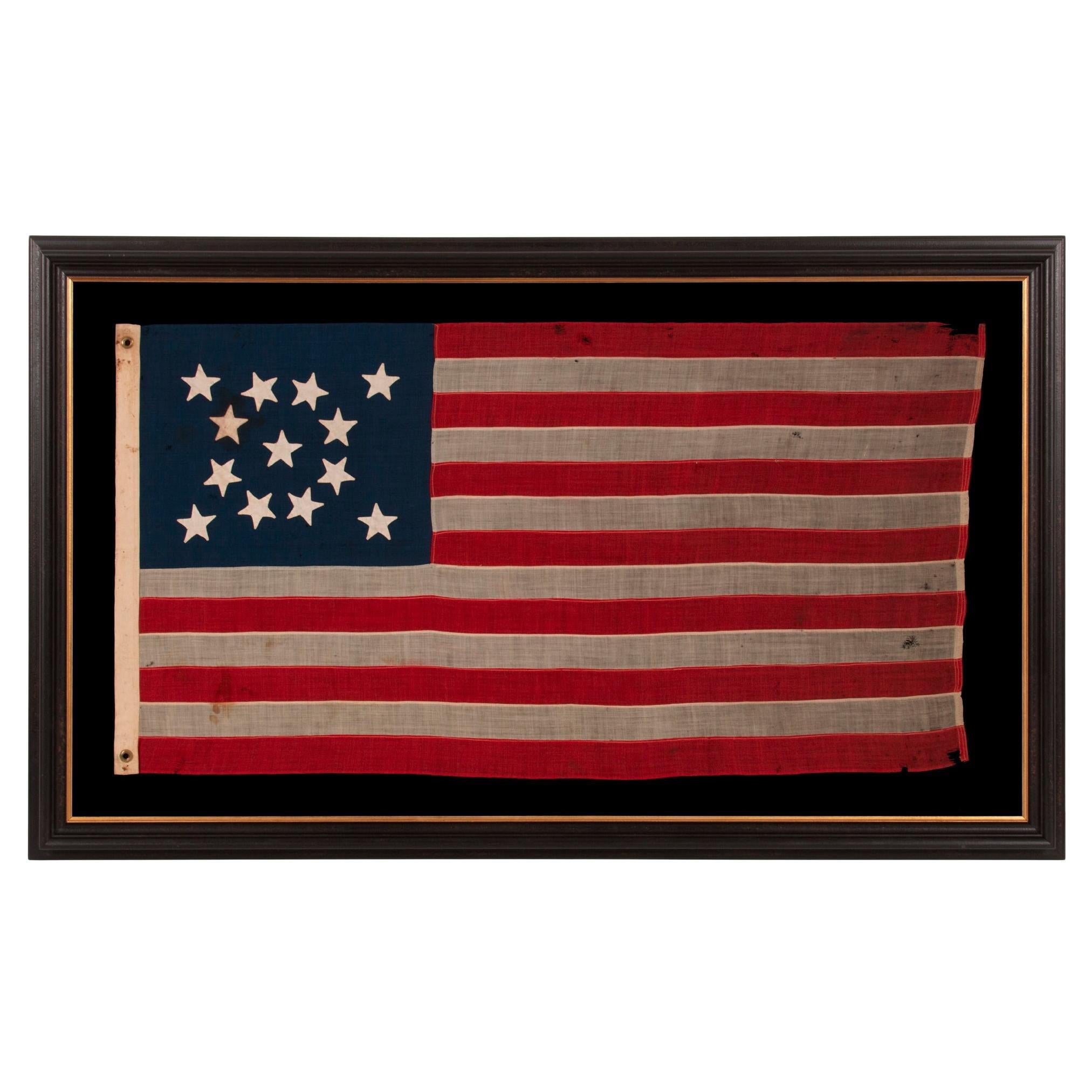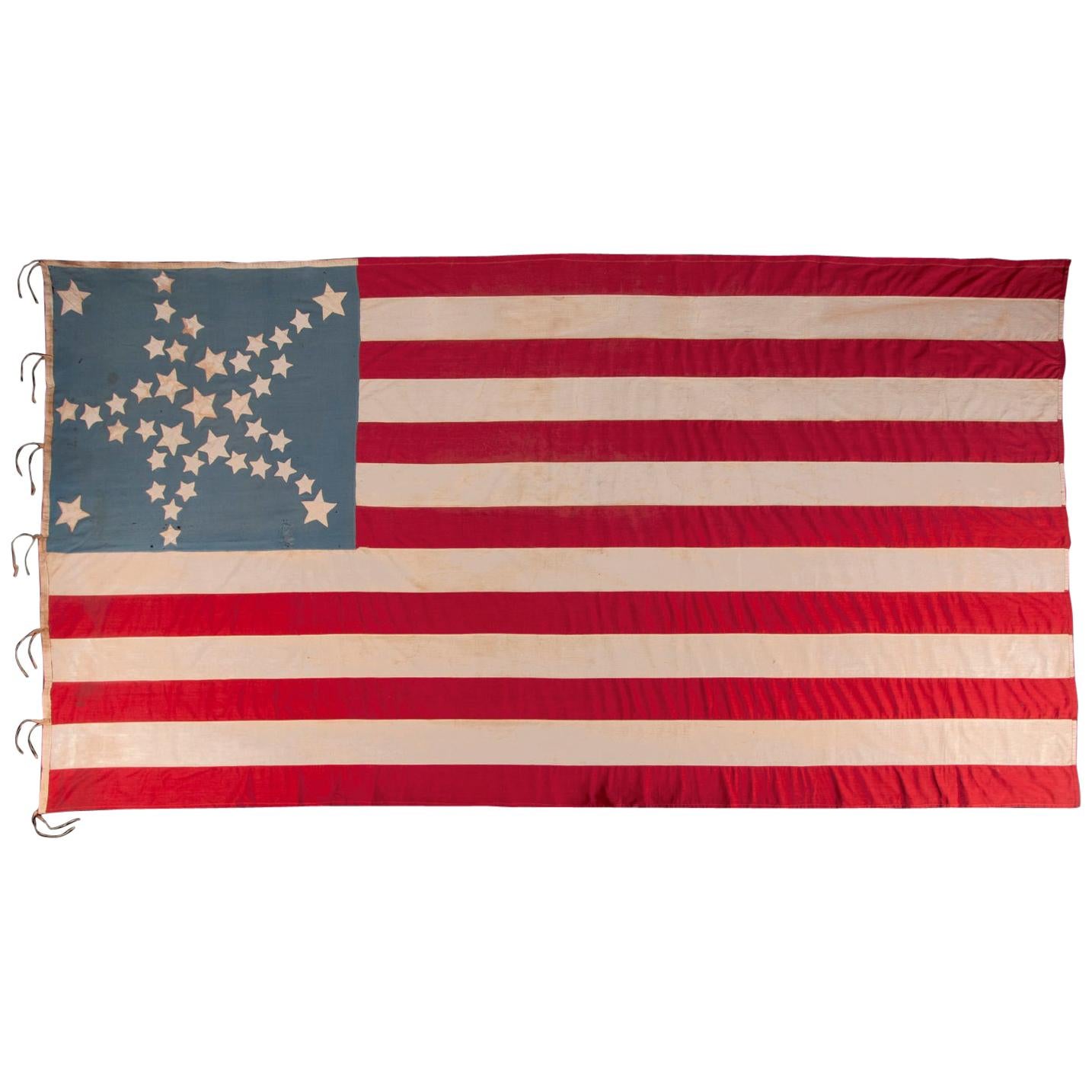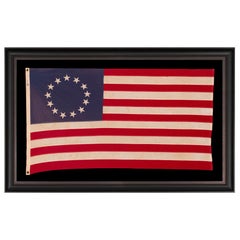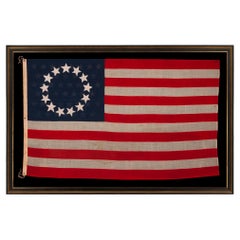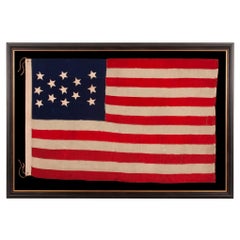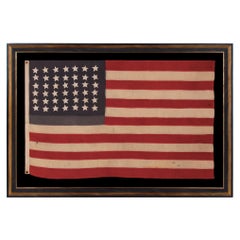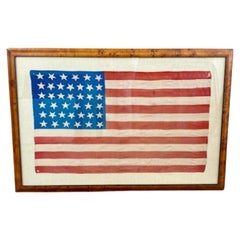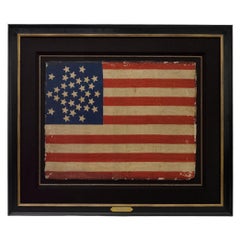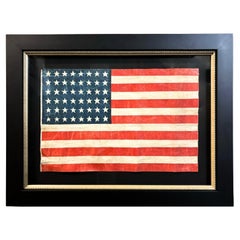Artículos similares a 13 Stars in a Betsy Ross Pattern, ca 1910-1926
¿Quieres más imágenes o vídeos?
Solicita imágenes o vídeos adicionales al vendedor
1 de 7
13 Stars in a Betsy Ross Pattern, ca 1910-1926
Precio a petición
Acerca del artículo
13 STARS IN THE BETSY ROSS PATTERN ON A SMALL-SCALE ANTIQUE AMERICAN FLAG MADE SOMETIME BETWEEN APPROXIMATELY 1910 AND THE 1926 SESQUICENTENNIAL OF AMERICAN INDEPENDENCE
13 star flag of the type made from roughly the last decade of the 19th century through the first quarter of the 20th. The stars are arranged in the circular wreath pattern most often associated with Betsy Ross. Flags in this design are widely admired, due to the longstanding popularity of the Betsy Ross myth. While many Americans were taught in grammar school that this was what our first flag looked like, there is unfortunately no way to prove the claim. No colonial examples have survived with this pattern of stars. In fact, I have encountered just three surviving examples of Betsy Ross pattern flags that I believe to pre-date the 1890's.
Because there was no official star pattern for the American flag until 1912, just after New Mexico and Arizona entered the Union as the 47th and 48th states, the arrangement before that time was completely left to the liberties of the maker. As a result, there are more than 80 known star patterns for the 13 star count alone.
The canton and stripes of the flag are made of wool bunting that has been pieced with machine stitching. The stars are made of cotton and double-appliquéd (applied to both sides) with a zigzag machine stitch. There is a twill cotton binding along the hoist with three white metal grommets, along which “2 x 3” appears in a black-inked stencil, near the top, on the obverse, to indicate size in feet. Adjacent to this and perpendicular to it, the number “11” is inscribed in black, while “No. 11” appears on the reverse of the binding in teal blue grease pencil. Near the top, a penciled inscription, difficult to decipher, reads “Betsy Ross.” Together the elements of the flag’s construction point to the period between approximately 1910 and the 1926 Sesquicentennial of American Independence.
Why 13 Stars? As the number of stars grew with the addition of new states, it became more and more difficult to fit their full complement on a small flag. The stars would, by necessity, have to become smaller, which made it more and more difficult to view them from a distance as individual objects. The fear was that too many stars would appear as one white mass, at a distance and distort the ability to identify American ships on the open seas.
The U.S. Navy flew 13 star flags on small craft for precisely this reason. This was, of course, the original number of stars on the first American national flag, by way of the First Flag Act of 1777, and equal to the number of original colonies that became states. To the Navy, a small flag generally meant anything short of 10 feet. Prior to the 1890’s, the smallest sewn flags encountered with any regularity were approximately 6 feet on the fly. Because the primary use had long been more utilitarian than decorative, flags needed to be large to be effective as signals. Private use grew with the passage of time, however, as did worldwide ability to recognize the American flag, both of led to the production of flags of smaller scale.
In 1864, the newly released regulations for U.S. Navy small boat ensigns assigned each specified size with a numeric designation. In 1864 and 1870 regs, a No. 11 ensign measured 4.2 feet on the hoist by 8 feet on the fly. This size designation was removed until 1914, when it reappears with corresponding measurements of 2.37 x 4.5 feet. In neither instance does this correlate with the 2 x 3 foot specs of the Betsy Ross pattern flag that is the subject of this narrative. The Navy made its own flags at various locations, some of which were marked and dated. Because they sometimes acquired them simultaneously from commercial makers, ships’ chandlers and other sources, all of which appear to have loosely followed Navy specs in such instances—or else the Navy remained flexible, perhaps caring more about expediency and price, actual measurements varied greatly. This is hardly the only time that I have seen Navy designation on a flag stenciled with measurements that only loosely correspond.
Beginning around 1890, commercial flag-makers began to produce smaller flags for the first time in large quantities. These typically measured either 2 x 3 feet (like this example), or 2.5 x 4 feet. Applying the same logic as the Navy, they selected the 13 star count rather than the full complement of stars, for the sake of ease and visibility. Any flag that has previously been official remains so according to the flag acts, so even today 13 star flags remain official national flags of the United States of America.
One of the interesting misconceptions about 13 star flags is that an open, circular wreath pattern, even if not the original design, must have been common in early America. Logic would suggest this, given the frequency with which it appears in modern times. This was not the case, however; in fact, the pattern is seldom encountered anywhere until much later. Exceptions include a 1779-1780 painting of George Washington at the Battle of Princeton, by Charles Willson Peale, that depicts, in the background, a flag that appears to have a circular wreath of stars, but no stripes. This is one of the few appearances of a circular pattern in a work period to the Revolutionary War, yet it wasn’t the national flag and Peale may have used some artist’s liberty in its inclusion. While known to be especially detailed and keen on accuracy, Peale made at least four copies of the painting prior to 1782, one of which shows the Battle of Trenton in lieu of Princeton (the original), so he obviously wasn’t opposed to alterations. Trumbull, included a flag with what may be a circular pattern in a 1787 painting of the Battle of Yorktown, but the flag is waving and it is not known if the intended design was to be circular or oval.
Francis Hopkinson, credited designer of the Stars & Stripes, actually rendered a circular pattern of 13 eight-pointed stars, presented like the rowels of a spur, on a piece of 1778 Philadelphia currency. This did not show a flag and was not part of one. He included a similar rendering, surrounding a liberty cap, on a 1778 draft for the seal of the U.S. Board of War, but there is a flag affixed to the liberty pole on which the cap rests, and the flag, which displays only stars, arranges them in a 4-3-4-2 lineal pattern.
The only surviving 18th-century illustration of a 13 star, Stars & Stripes with a circular wreath and no center star, appears in a sketch by William Barton, which served as his 2nd draft for the Great Seal of the United States, presented to the 3rd Committee designated to select it. Though it does not survive, Barton’s first draft is also said to have included such a flag. The final draft was not rendered by Barton, but by Congressional Secretary Charles Thompson, who included no flags, but did include an arrangement of 13 stars above the head of a federal eagle, placed in a random pattern. It is of interest to note that Francis Hopkinson produced some of the initial drafts of the seal, which also included 13 stars in a random scatter (fig. 4).
One of the best arguments against the Betsy Ross pattern having appeared on the original flag is illustrated by the fact that so many 13 star flags exist without it. If the Ross design was the original, it stands to reason that the pattern would have been reproduced with at least some degree of frequency.
Research conducted by the National Museum of American History notes that the story of Betsy Ross making the very first American flag for General George Washington, in the company of George Ross and Robert Morris, entered into American consciousness about the time of the 1876 centennial. The tale was immensely popular among an American public eager for stories about the Revolution and its heroes. The first documentation of the narrative appeared shortly beforehand, in 1870, in a paper written by Betsy’s grandson, William Canby, for the Pennsylvania Historical Society. At the time Canby made no mention of how the flag was designed, save for the fact that it had 5-pointed stars, per his grandmother’s suggestion. Because no earlier documentation supports the story, most flag scholars feel it was a grand hoax, fabricated by Canby for his own interests. Nothing survives in the collective writings of the three men, for example, nor in records of their words and deeds, which are fairly extensive. As with most things, reality is perhaps somewhere in the middle ground, with some of the details based on fact and some on fiction, made up, misinterpreted, or imagined from family accounts.
The first time that a star configuration gets attached to the Ross story appears to have occurred during the last decade of the 19th century. In 1892, Charles Weisgerber painted a nine-by-twelve-foot rendition of the fabled meeting between Betsy and George Washington, in which there is a flag with a circular wreath. Shortly afterwards, in 1898, Betsy’s granddaughter and great-granddaughter began to make flags in the East Wing of Independence Hall in Philadelphia, selling them to tourists while disseminating family folklore. In that same year, Weisgerber and a “group of concerned citizens” sought to preserve Betsy’s former Philadelphia residence at 239 Arch Street, where she lived at the time the flag would have been sewed. Weisgerber moved his family into the house and immediately opened to the public the room in which Betsy was said to have worked her magic. Ten-cent memberships were sold to fund renovations and donors received a small calendar, to which a cotton 13 star Betsy Ross pattern parade flag was affixed. The effects of these events caused the Ross legend to stick and the story, with the corresponding flag design, has appeared ever since in more places than one could ever hope to count.
Mounting: For 25 years we have maintained our own textile conservation department, led by a master’s degree level graduate from one of the nation’s top university programs. We take great care in the mounting and preservation of flags and related textiles and have preserved thousands of examples.
The background is 100% cotton twill, black in color, that has been washed and treated for colorfastness. The black-painted, hand-gilded and distressed molding is Italian. The glazing is U.V. protective Plexiglas.
Condition: There is extremely minor spoiling along the hoist binding, but there are no significant condition issues.
Frame Size (H x L): Approx. 36" x 49"
Flag Size (H x L): 24" x 37"
- Dimensiones:Altura: 91,44 cm (36 in)Anchura: 124,46 cm (49 in)Profundidad: 6,35 cm (2,5 in)
- Materiales y técnicas:
- Época:
- Fecha de fabricación:1910-1926
- Estado:See Item Description.
- Ubicación del vendedor:York County, PA
- Número de referencia:Vendedor: 13j-17151stDibs: LU849745343272
Sobre el vendedor
5,0
Vendedor reconocido
Estos prestigiosos vendedores son líderes del sector y representan el escalón más alto en cuanto a calidad y diseño de artículos.
Establecido en 1991
Vendedor de 1stDibs desde 2008
70 ventas en 1stDibs
Tiempo de respuesta usual: Varios días
- EnvíoRecuperando presupuesto…Envío desde: York County, PA
- Política de devolución
Partes de esta página se han traducido automáticamente. 1stDibs no puede garantizar la exactitud de las traducciones. El inglés es el idioma predeterminado de este sitio web.
Garantía de autenticidad
En el improbable caso de que haya algún problema con la autenticidad de un artículo, ponte en contacto con nosotros en un plazo de 1 año para recibir un reembolso total. DetallesGarantía de devolución de dinero
Si tu artículo no es como se describe, sufre daños durante el transporte o no llega, ponte en contacto con nosotros en un plazo de 7 días para recibir un reembolso total. DetallesCancelación dentro de las 24 horas
Tienes un período de gracia de 24 horas para reconsiderar tu compra, sin preguntas.Vendedores profesionales aprobados
Nuestros vendedores de primera clase deben cumplir estrictos estándares de servicio para mantener la integridad de nuestros anuncios.Garantía de igualación de precios
Si encuentras que un vendedor publicó el mismo artículo por un precio menor en otro lado, igualaremos ese precio.Entrega global de confianza
Nuestra red de transporte de primera ofrece opciones de envío especializado en todo el mundo, que incluye envío personalizado.Más de este vendedor
Ver todo13 Estrellas, Bandera Patrón Betsy Ross, Fabricada por la Compañía Annin, ca 1955-1965
13 ESTRELLAS EN EL PATRÓN DE BETSY ROSS, SOBRE UNA ANTIGUA BANDERA ESTADOUNIDENSE, FABRICADA POR LA COMPAÑÍA ANNIN DE NUEVA YORK Y NUEVA JERSEY, circa 1955 - 1965
Bandera nacional e...
Categoría
finales del siglo XX, Estadounidense, Recuerdos políticos y patrióticos
Materiales
Algodón
Bandera Americana Antigua con 13 Estrellas en el Diseño de Betsy Ross y 45 Estrellas en el Reverso
13 ESTRELLAS EN EL DIBUJO DE BETSY ROSS, CON 45 ESTRELLAS EN EL REVERSO; EN UNA ANTIGUA BANDERA ESTADOUNIDENSE HECHA Y FIRMADA POR UNA ARMADORA DE BANDERAS ANTERIORMENTE NO IDENTIFI...
Categoría
Antiguo, Década de 1890, Estadounidense, Otro, Recuerdos políticos y pat...
Materiales
Lana, Algodón
Bandera Americana Antigua de 13 Estrellas con Presentación de Estrella Estrecha, ca 1876
BANDERA AMERICANA ANTIGUA DE 13 ESTRELLAS CON ESTRELLAS COSIDAS A MANO EN UNA PRESENTACIÓN EXTREMADAMENTE ESTRECHA DE UNA DISPOSICIÓN 3-2-3-2-3 SOBRE UN CANTÓN QUE NO SIGUE EL EJEMPL...
Categoría
Antiguo, Década de 1870, Estadounidense, Recuerdos políticos y patrióticos
Materiales
Lana
42 Estrellas Cosidas a Mano en una Bandera Americana Antigua ca 1889-1890
42 ESTRELLAS COSIDAS A MANO EN UNA ANTIGUA BANDERA ESTADOUNIDENSE CON UN CANTÓN AZUL EN DOS TONOS, REFLEJA LA ADICIÓN DEL ESTADO DE WASHINGTON, MONTANA Y LAS DAKOTAS, NUNCA SE HIZO U...
Categoría
Antiguo, Fines del siglo XIX, Estadounidense, Recuerdos políticos y patr...
Materiales
Lana
Bandera americana antigua de 13 estrellas , Estrellas cosidas a mano en un medallón, Centenario de 1876
BANDERA AMERICANA ANTIGUA DE 13 ESTRELLAS CON UNA CONFIGURACIÓN DE MEDALLÓN DE ESTRELLAS COSIDAS A MANO Y UN HERMOSO PERFIL ALARGADO, FABRICADA EN LA ÉPOCA DEL CENTENARIO DE LA INDEP...
Categoría
Antiguo, Década de 1870, Recuerdos políticos y patrióticos
Materiales
Lana
Bandera Americana de 34 Estrellas, Actualizada a 39 Estrellas, con Estrellas en un Patrón de Grandes Estrellas
34 ESTRELLAS EN UNA CAPRICHOSA INTERPRETACIÓN DEL MOTIVO DE LA GRAN ESTRELLA, EN UNA BANDERA DE LA ÉPOCA DE LA GUERRA CIVIL CON UN CANTÓN AZUL ACIANO, ACTUALIZADA A 39 ESTRELLAS EN 1...
Categoría
Antiguo, Década de 1870, Estadounidense, Recuerdos políticos y patrióticos
Materiales
Algodón
Precio a petición
Envío gratuito
También te puede gustar
Bandera estadounidense de 39 estrellas del siglo XIX, hacia 1889
Bandera estadounidense de 39 estrellas del siglo XIX, circa 1889, bandera de desfile de seda estampada de época con un motivo ondulado de estrellas danzantes. Nunca fue una bandera o...
Categoría
Antiguo, Década de 1880, Estadounidense, Federal, Recuerdos políticos y ...
Materiales
Seda
Bandera Americana Impresa de 31 Estrellas, Celebrando la Independencia del Estado de California, Circa 1850
Ésta es una rara bandera estadounidense impresa en medallón de 31 estrellas, que celebra la incorporación de California a la Unión. La bandera está impresa en seda y tiene un especta...
Categoría
Antiguo, Década de 1850, Estadounidense, Recuerdos políticos y patrióticos
Materiales
Seda
Bandera estadounidense de 45 estrellas, impresa en algodón, que celebra la condición de estado de Utah, 1896-1908
Esta bandera de 45 estrellas de Estados Unidos celebra la condición de estado de Utah. Las banderas de 45 estrellas fueron la bandera oficial de Estados Unidos entre 1896 y 1908. Est...
Categoría
Antiguo, Década de 1890, Estadounidense, Recuerdos políticos y patrióticos
Materiales
Algodón
Bandera Americana Impresa de 48 Estrellas, Conmemorativa del Estado de Arizona, 1912-1958
Se trata de una bandera de desfile original estadounidense de 48 estrellas, que celebra la condición de estado de Arizona. Maravilloso producto de la historia temprana de nuestra nac...
Categoría
mediados del siglo XX, Estadounidense, Recuerdos políticos y patrióticos
Materiales
Tela
Bandera Americana Antigua de 38 Estrellas con Cantón Único, circa 1876-1890
Esta es una llamativa bandera estadounidense de 38 estrellas. La bandera data de 1876-1890, cuando Colorado (representado por la gran estrella en el centro del cantón de la bandera) ...
Categoría
Antiguo, Fines del siglo XIX, Estadounidense, Recuerdos políticos y patr...
Materiales
Muselina
Bandera Americana Impresa de 39 Estrellas, Conmemorativa de la Independencia del Estado de Dakota del Norte, 1889-1890
Ésta es una bandera estadounidense no oficial de 39 estrellas, que celebra la condición de estado de Dakota del Norte. La bandera impresa data de 1889 y presenta un "caprichoso" dibu...
Categoría
Antiguo, Década de 1880, Estadounidense, Recuerdos políticos y patrióticos
Materiales
Tela
